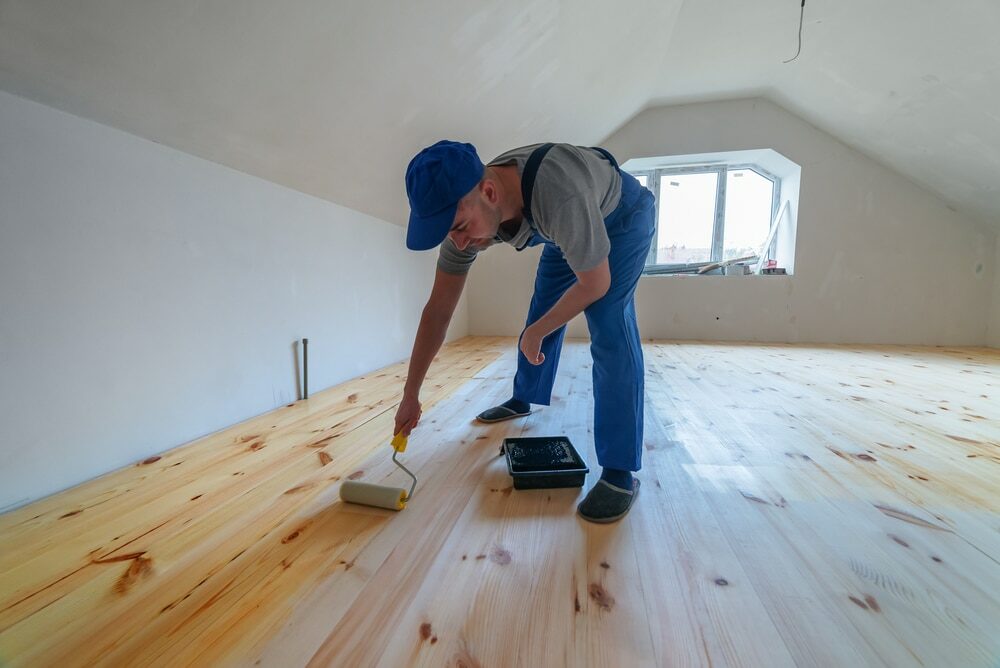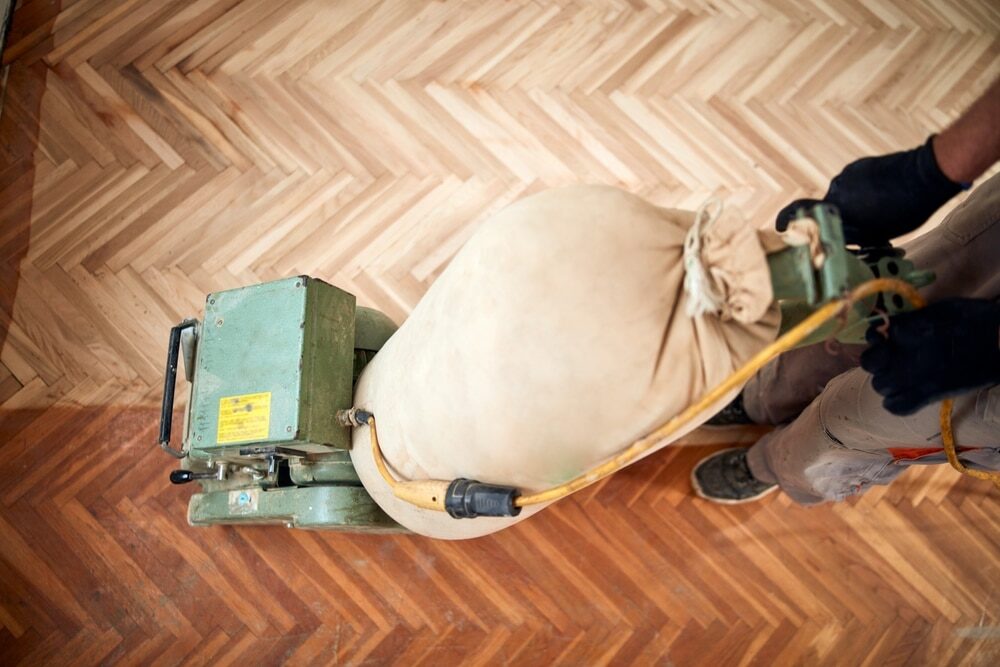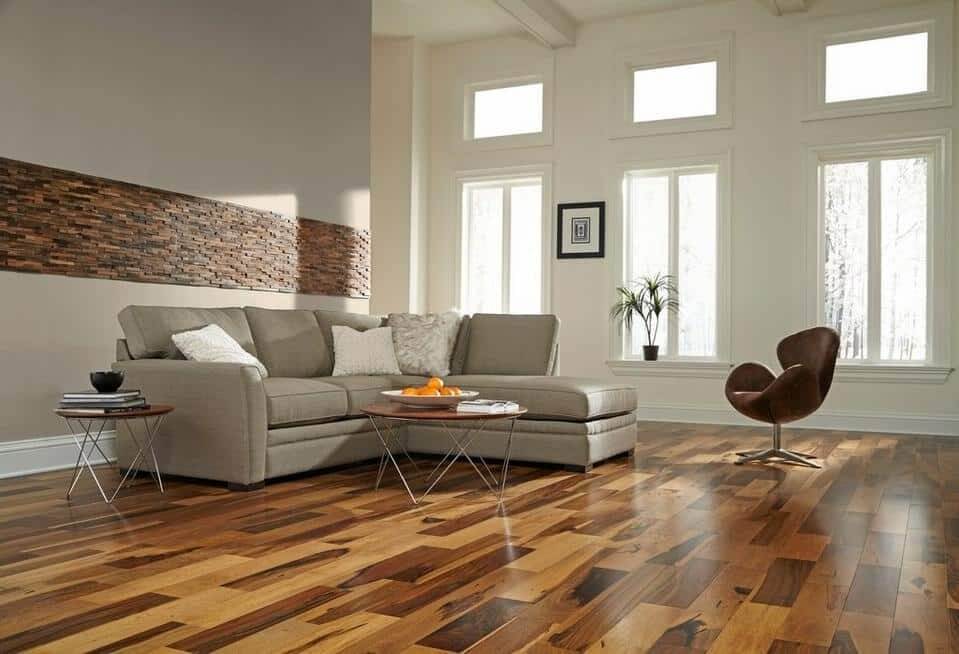London:
Nationwide:
The Benefits of Dry Buffing for Floor Sanding
Posted on October 9, 2023
Buffing
Unlocking the Advantages: Why Dry Buffing is Essential for Wood Floor Sanding
The world of floor maintenance has seen various techniques to ensure that surfaces not only appear polished but also retain their longevity. One such method that has gained immense popularity in recent years is dry buffing. Unlike traditional floor sanding methods that may utilise moisture or solvents, dry buffing stands out because of its minimalistic approach that doesn’t compromise on quality. By eliminating the need for water or chemicals during the sanding process, this method offers a slew of benefits, ranging from environmental advantages to operational efficiencies. Imagine a floor gleaming in its full splendour, immaculate and free of blemishes. This visual appeal is often achieved through meticulous sanding and polishing processes. Dry buffing, an innovative approach to floor sanding, ensures this result without the pitfalls of conventional wet sanding methods. Harnessing the power of mechanical friction, dry buffing transforms dull, lifeless floors into surfaces that speak of brilliance and durability. As one delves deeper into this method, the myriad benefits it offers become evidently clear.
Over the years, floor maintenance has evolved, adapting to the changing needs of infrastructure and the demands of consumers. Among the advancements in this realm, dry buffing for floor sanding emerges as a frontrunner. This technique, which relies on the raw efficiency of abrasive pads without the use of liquids, is proving to be a game-changer. From eco-friendly practices to enhanced floor preservation, dry buffing offers an alternative that is not only effective but also environmentally and economically sound.
Imagine a floor gleaming in its full splendour, immaculate and free of blemishes. This visual appeal is often achieved through meticulous sanding and polishing processes. Dry buffing, an innovative approach to floor sanding, ensures this result without the pitfalls of conventional wet sanding methods. Harnessing the power of mechanical friction, dry buffing transforms dull, lifeless floors into surfaces that speak of brilliance and durability. As one delves deeper into this method, the myriad benefits it offers become evidently clear.
Over the years, floor maintenance has evolved, adapting to the changing needs of infrastructure and the demands of consumers. Among the advancements in this realm, dry buffing for floor sanding emerges as a frontrunner. This technique, which relies on the raw efficiency of abrasive pads without the use of liquids, is proving to be a game-changer. From eco-friendly practices to enhanced floor preservation, dry buffing offers an alternative that is not only effective but also environmentally and economically sound.
Introduction to Wood Floor Sanding
Wood floor sanding is an art and science, a process that breathes life back into aged and worn wooden surfaces, restoring their innate charm and beauty. Over time, even the most pristine wood floors inevitably show signs of wear, whether it’s from routine foot traffic, accidental spills, or the passage of time itself. As these floors lose their sheen and become marred with scratches and imperfections, they cry out for rejuvenation. Enter wood floor sanding, a method that meticulously removes the top layer of the wood, erasing blemishes and setting the stage for a fresh finish. Beyond just the aesthetic appeal, sanding also ensures the longevity and durability of wooden floors. For homeowners and professionals alike, understanding the nuances of this process is crucial, as it can transform a lacklustre floor into a centrepiece of elegance and warmth.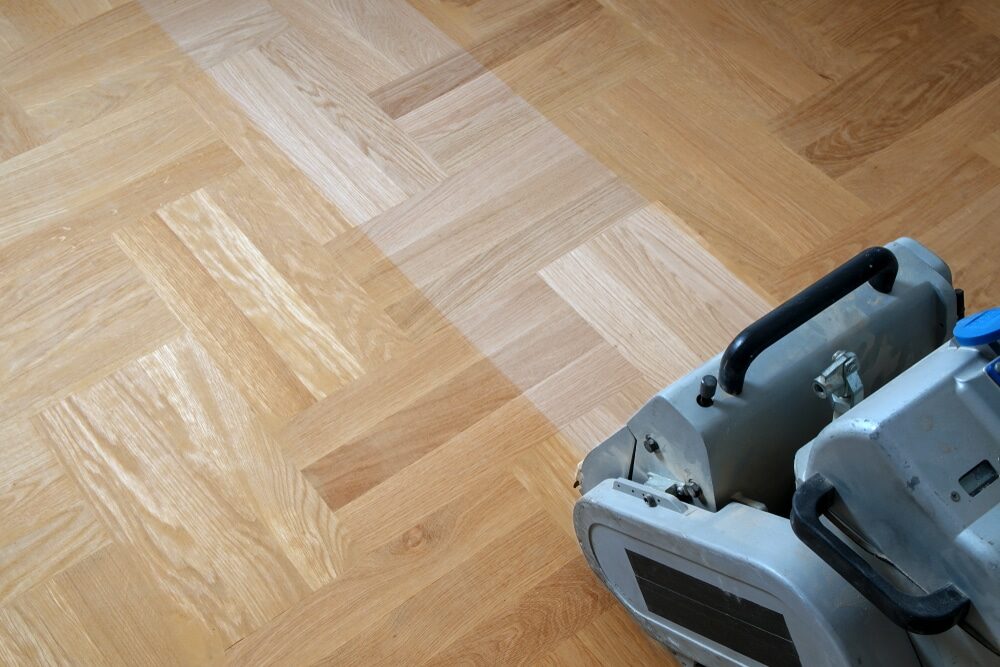
What is dry buffing?
Dry wood floor buffing is a specialised technique used to enhance the appearance and longevity of wooden floors without the need for a full sanding procedure. Instead of removing layers of the wood, as traditional sanding does, dry buffing focuses on the topmost layer, especially the finish or sealant. Here’s a closer look at this method:- Technique: Dry buffing utilises a floor buffer, which is a machine equipped with a large, round abrasive pad. This pad rotates at high speeds, creating friction against the floor’s surface.
- Purpose: The primary goal of dry buffing is to smooth out minor scratches, scuffs, or imperfections that might be present on the surface. It can also help to refresh the sheen and lustre of a wood floor, especially if the finish has become dull over time.
- Benefits: Dry buffing is less invasive than full-scale sanding. It’s quicker, produces less dust, and typically costs less. Since it doesn’t significantly reduce the thickness of the floor, it can be a preferred method for floors that have been sanded multiple times previously.
- Application: After the buffing process, a new coat of sealant or finish can be applied, further enhancing the floor’s protection and appearance.
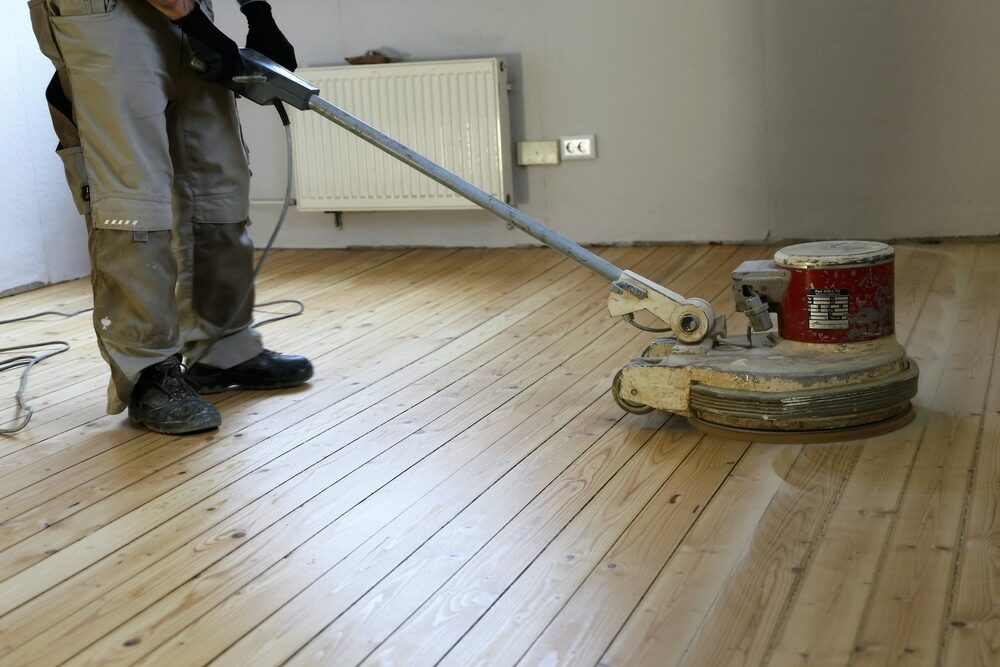
Tools and materials needed for dry buffing
To achieve the best results when dry buffing a wood floor, it’s essential to have the right tools and materials on hand. Here’s a comprehensive list to ensure you’re well-prepared for the task:Tools:
- Buffing Machine (Floor Buffer): This is the primary tool for dry buffing. They come in various sizes, but for residential use, a 13- to 17-inch-diameter pad drive is commonly used.
- Buffing Pads: These are attached to the bottom of the buffing machine. You’ll want a variety of grit levels, depending on the condition of your floor and the desired finish.
- Dust Masks and Safety Glasses: It’s essential to protect yourself from dust and any potential wood particles that can be harmful when inhaled or can enter the eyes.
- Ear Protection: Buffing machines can be noisy, so it’s a good idea to use earplugs or earmuffs.
- Vacuum Cleaner: A good vacuum helps remove the dust after buffing, ensuring a clean surface for applying finishes if desired.
- Extension Cord: Ensure that it’s long enough to reach all parts of the room without having to constantly switch outlets.
- Soft Bristle Brush or Broom: This is for initial cleaning of the floor before buffing.
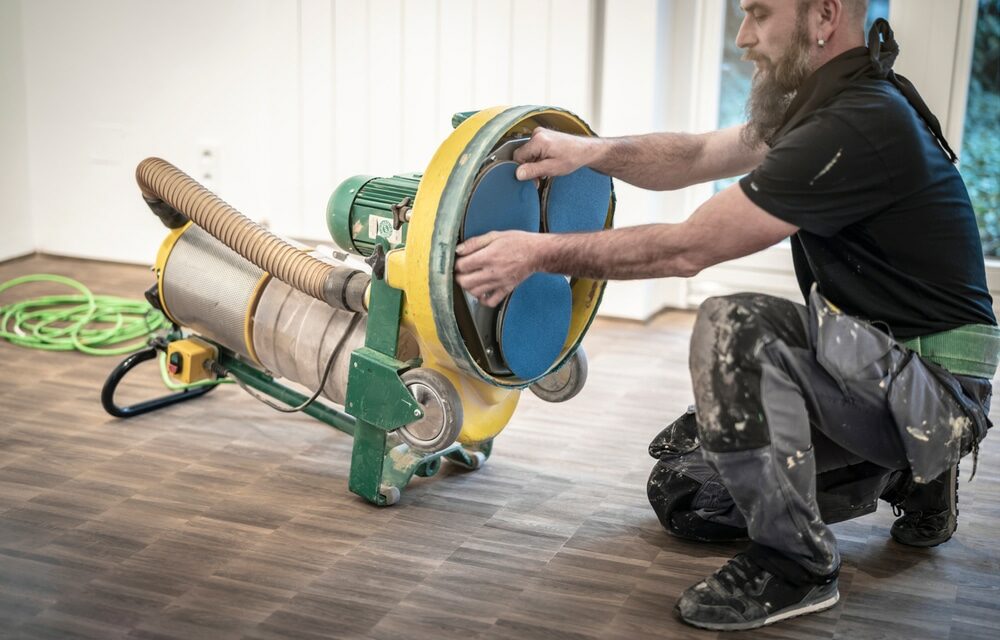
Materials:
- Screening Discs: These abrasive screens are used in conjunction with the buffer to lightly abrade the wood surface, preparing it for the final finish.
- Wood Floor Cleaner: A pH-neutral cleaner is recommended to ensure there’s no damage to the wood.
- Tack Cloth: This sticky cloth is helpful for picking up any leftover dust or debris after vacuuming.
- Wood Floor Finish (optional): If you’re planning to apply a new finish after buffing, have this on hand. Make sure it’s compatible with your wood type.
- Applicator (optional): If you’re refinishing the floor after buffing, you’ll need an applicator to spread the finish evenly.
- Clean Rags: Essential for cleaning up any spills and for hand wiping certain areas if necessary.
- Knee Pads: If you need to work on specific spots by hand or if you’re applying a finish manually, knee pads can save your knees from discomfort.

Advantages of dry buffing
A. Environmental Benefits- Reduced Waste: Unlike full-scale sanding, which produces a considerable amount of wood dust and waste, dry buffing creates much less debris, leading to a reduced environmental footprint.
- Less Chemical Use: The process doesn’t always require chemicals or solvents, meaning fewer emissions and pollutants are released into the environment.
- Energy Efficiency: Dry buffing machines typically consume less power than heavy-duty sanders, leading to energy savings.
- Cost-Effective: Dry buffing is typically more affordable than a full refinish or sanding job, saving homeowners and businesses money.
- Decreased Maintenance Costs: Regular buffing can extend the time between full-scale sanding and refinishing projects, further reducing long-term expenses.
- Preservation: By maintaining floors regularly with buffing, you can prolong the life of the wood, potentially saving on replacement costs in the long run.
- Quicker Process: Buffing a floor can be accomplished much faster than sanding and refinishing.
- Immediate Use: Once the buffing and subsequent sealant application (if done) are complete, spaces can be used almost immediately, unlike sanding, which often requires a longer waiting period.
- Minimal Setup and Cleanup: With less dust and disruption, the setup and cleanup times are significantly reduced.
- Restored Shine: Dry buffing can quickly restore the lustre and sheen of a wood floor, making it look refreshed and new.
- Even Finish: The process can smooth out minor imperfections, giving the floor a more uniform appearance.
- Enhanced Grain Visibility: Buffing can often enhance the natural grain and beauty of the wood without the need for deep sanding.
- Surface Integrity: Buffing maintains the integrity of the wood surface, ensuring it remains protected from everyday wear and tear.
- Less Invasive: Since dry buffing is less aggressive than traditional sanding, there’s less wear on the floor, preserving its thickness and structure.
- Re-seal Opportunities: After buffing, a new protective layer of sealant or finish can be applied, offering an added layer of protection against potential damage.

Tips for Effective Dry Wood Floor Buffing:
- Select the right equipment: Ensure you use a high-quality buffer that’s suitable for wood flooring. The choice of buffer pads is equally essential; use the appropriate level of abrasiveness for your floor type and condition.
- Clean the Floor First: Before buffing, thoroughly clean the floor to remove any dirt, grit, or debris. Even small particles can cause scratches during the buffing process.
- Test a Small Area: Before buffing the entire floor, test a small, inconspicuous area to ensure the results are as expected.
- Move the Buffer Consistently: Move the buffer in a consistent, side-to-side motion, ensuring you don’t stay too long in one spot, which could lead to uneven results.
- Overlap Passes: To avoid missing any areas or leaving noticeable transitions, slightly overlap each pass with the buffer.
- Replace Pads as Needed: As buffer pads become dirty or worn, they become less effective. Regularly check and replace them as necessary.
- Stay in Control: Always maintain control of the buffer. Applying too much pressure or letting it “run away” can cause damage.
- Dust as You Go: After buffing sections of the floor, dust or vacuum up the fine particulate that’s produced to keep the area clean.
- Reapply a Finish or Sealant: Once buffing is complete, consider applying a fresh coat of finish or sealant. This will enhance the shine and offer protection.
- Regular Maintenance: Incorporate dry wood floor buffing into a regular maintenance routine. Doing so periodically can help maintain the floor’s aesthetics and prolong the time between intensive sanding jobs.
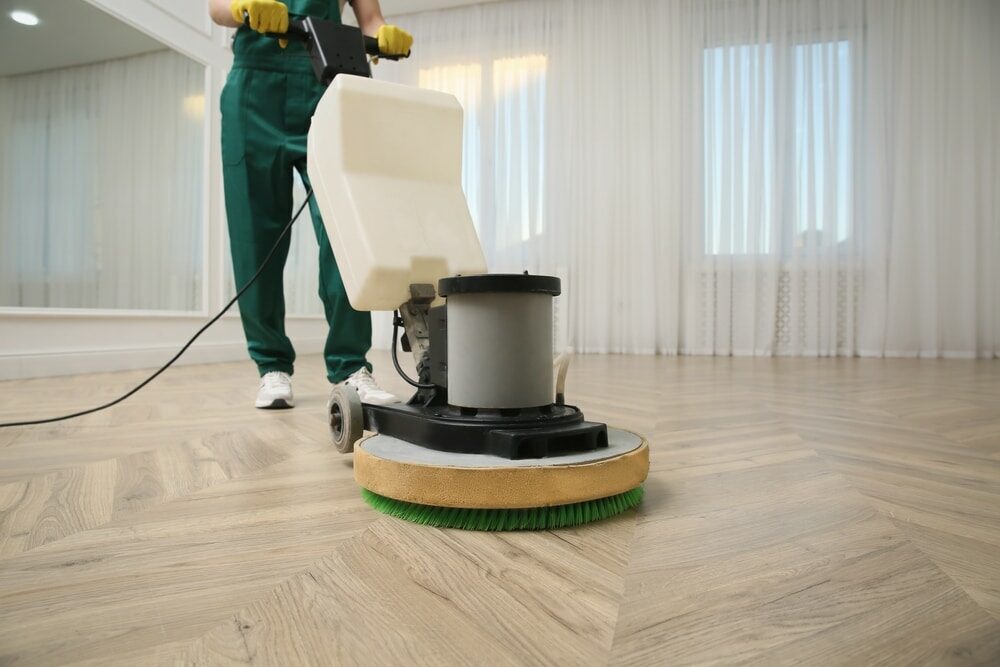
Conclusion
Dry wood floor buffing stands as a testament to the advancements in floor maintenance. It offers a balance between gentle care and effective restoration. By following these tips, homeowners and professionals alike can ensure the best results, rejuvenating the floor’s appearance while preserving its character and longevity. This method proves that maintaining the grandeur of wooden floors doesn’t always necessitate aggressive treatments; sometimes, a subtle touch can make all the difference. The allure of wood floors lies not just in their timeless beauty but also in their ability to be revitalised again and again. Dry wood floor buffing epitomises this transformative power, offering a sustainable and efficient method of floor rejuvenation. As people become more environmentally conscious and time-sensitive, techniques that prioritise both the environment and convenience become invaluable. With every buff, we’re not just restoring a surface; we’re reaffirming our commitment to sustainable practices that honour the natural resources in our homes. In the realm of wood floor maintenance, there’s a delicate dance between preserving the past and embracing the future. Dry wood floor buffing gracefully straddles this line. It respects the age-old charm of wooden floors while leveraging modern techniques for optimal results. For those seeking to breathe new life into their floors without a hefty price tag or an extensive timeline, this method shines brightly. It’s a gentle reminder that sometimes the most effective solutions are those that work in harmony with what already exists, enhancing rather than replacing.Some Useful Links:
- Stairs Sanding & Refinishing
- Floor Sanding Services
- School Floor Sanding
- Wood Floor Restorations
- Wood Floor Repairs
- Wood Floor Polishing
More from our Blog:
Buffing vs Polishing: What’s the Difference? Different Buffing Techniques for Hardwood Floors The Role of Buffing in Achieving a Smooth Finish How to Choose the Right Buffer for Floor Sanding How to Repair Damaged Floors with Belt Sanding Step-by-Step Guide to Belt Sanding Your Floors Innovative Techniques for Using Belt Sanders in Floor Refinishing How to Achieve a Perfectly Flat Surface with Belt Sanding for Floor Refinishing Common Belt Sanding Tools and Accessories for Floor Refinishing
Sanding
We provide virtually dust-free sanding with our continuous belt machinery with mobile extraction units, giving you a safer environment for your family.
Oiling
This organic finish not only adds beauty to your home but also has exceptional water-repellent characteristics, making it easier to clean and maintain.
Waxing
This natural floor finish offers the softest and most mellow appearance – and leaves your floor able to breath.
Buffing
Using soft buffing machines (and hand-polishing where required) will bring a wonderful sheen to your newly-finished floor.
Repairs
We offer a full assessment of your wooden floors to determine what repairs are needed to provide the perfect working surface for the later stages of sanding, staining and sealing.
Restoration
We offer a comprehensive restoration process designed to address floors that are improperly fitted or damaged over time through wear and tear.
Request a fixed price quote for your wood floor restoration now
Simply enter your postcode below to get started.
Services
Wood Floor Sanding Wood Floor Restoration Wood Floor Scratch Repair Squeaky Wood Floor Repair Parquet Floor Sanding Parquet Floor Restoration Commercial Floor Sanding Church Floor Sanding Community Centre Floor Sanding School Floor Sanding Gap Filling Gap Filling with ResinCopyright © Mr Sander®
Privacy & Cookies Terms & Conditions Complaints Procedure Cancellation Rights Sitemap